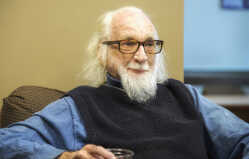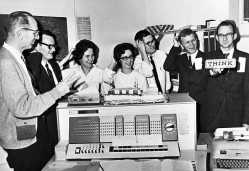For DePauw computer science, hindsight is 20/50

Earlier this year, a gift from Professor Emeritus of Mathematics and Computer Science Robert "Bob" J. Thomas and his wife, Doris, established the DePauw Computer Science Founders Fund for Excellence.
Created to keep the department at the forefront of computer science education, the fund honors the 50th anniversary of pioneering work done by Thomas, the 20th anniversary of the creation of DePauw's Department of Computer Science, and work done by the department's three founding members to build on Thomas' vision.
Thomas arrived at DePauw in 1958, long before a computer science department existed.
In fact, DePauw didn't even own a computer. The practicality of teaching computer science under those conditions was met with reasonable skepticism from Clinton B. Gass, head of the mathematics department under which Thomas' course would fall.
"Dr. Gass and another long-term professor here wondered how I could teach a computer science course without a computer, so they audited the course and attended every lecture," remembers Thomas, who still resides in Greencastle. "Somehow it did not bother me as a new teacher to have the department head listening to my every word."
Only slightly hampered by the lack of a campus computer (and the close supervision), Thomas taught principles of computer science such as binary and hexadecimal number systems, Boolean algebra and logical design, though he still found a way to introduce students to programming.
They would write simple programs using punched paper tape and take them to Rose Polytechnic Institute, now Rose-Hulman Institute of Technology, to run on a computer there. The somewhat unorthodox course met Gass' satisfaction, and Thomas was allowed to continue with it.
In 1961, just before Thomas went on sabbatical to complete a Ph.D. at University of Illinois, DPU President Russell J. Humbert visited him at his house and asked if he would be the first director of a new computer center.
Thomas later learned that this arrangement -- to which he agreed -- was made to secure a National Science Foundation (NSF) grant for the university's first computer, a desk-sized and -shaped IBM 1620 punch-card model.
IBM delivered the computer while Thomas was still on sabbatical, and as he was the only person on campus capable of operating or even comprehending the $120,000 machine, he returned to find it being held in particularly poor storage.
"The computer was stored outdoors in below freezing weather, but it was OK," Thomas recalls.
Thomas set the computer up in the basement of the Studebaker Administration Building and in spring 1963 used it to teach DePauw's first course with an on-campus computer.

Thomas continued to lead the computer science curriculum within the mathematics department until his retirement from DePauw in 1991. His departure left a hole that no single faculty member could truly fill, and an independent computer science department was formed shortly thereafter in 1993 with three founding faculty members: Carl P. Singer, a 1966 graduate and a student of Thomas who retired in 2007, and Dave A. Berque and Gloria Childress Townsend, who continue to teach.
Though the department had split off from mathematics, Berque, Singer and Townsend were creating a new curriculum at the same time as most of America was being introduced to the Internet. By then, computer science had matured into something that could complement nearly anything being taught on DePauw's campus.
The three professors seized upon that flexibility, creating new courses and programs to introduce a wider range of students to the discipline.
"Even in the early days of the department, I think all three of us were interested in the human side of computing, probably more so than was typical for computer science departments at that time," says Berque, whose DEBBIE classroom tablet computing system was commercialized as DyKnow Vision in 2003.
Built from the ground up for the new department, Singer's Computer Science I course invited curious students to give computer science a closer look, while Townsend launched her Women in Computer Science organization to attract and support an under-represented female student population.
Their inclusive, interdisciplinary approach defined the new department. In May 1993, seven months before the transition to an independent department, eight computer science majors graduated from DePauw. This number climbed during the following years, with 30 graduates in 2000 and 46 in 2005, which is similar to the number of graduates the department anticipates this year.
"Measured by graduated students, the department became what we believe is the largest liberal arts computer science department in the country," Townsend says.
Perhaps more significant than the number of graduates is the fact that the department graduates female computer science majors at a rate that is more than double the national average.
The department's successes haven't come at the cost of the small college experience, however. Since 1993, the computer science faculty has more than doubled from the original three members to seven, broadening the scope of the department's scholarship and research.
By keeping the student-professor ratio low, students have benefited from more opportunities for collaboration on ongoing projects and closer advising for academics, internships and post-graduation plans. And, Berque says, so have faculty members.
"If you walk up and down the hall of our department and ask faculty members what gives them the most pleasure, I think they would all say that it is watching our students succeed and knowing we played a role in that," Berque says. "Many of our majors keep in touch for decades after graduation. It's very exciting to see them excel."
